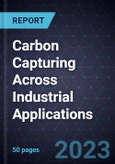Roadmap to Industrial Decarbonization through Carbon Capture Storage and Utilization Growth Strategies
Carbon capture utilization and storage is gaining industry traction as a highly effective decarbonizing strategy. Global efforts to combat climate change, government incentives and industrial emission regulations, eco-conscious consumers, and green technology advancements are among the factors driving the need for CCUS solutions.
CCUS implementation can only succeed when forces, including technology maturity, regulatory support, and industrial collaborations, align to create cross-sectoral benefits. This research study identifies the three pillars of CCUS: Government, Technology, and Environment. Many countries enact initiatives and allocate funding to meet net zero commitments. The report identifies notable incentives and project rollouts by leading economies. It also highlights the main technologies catering to the needs of the CCUS process and enhancing overall process efficiency. As the rising carbon footprint is among the primary drivers of CCUS deployment, industries increasingly recognize CCUS as the tool for decarbonization to achieve zero emission goals in the short term.
Despite its potential, CCUS has potential risks and challenges linked to its implementation owing to the lack of technology maturity. Implementing the CCUS value chain also requires significant investment, leading to low adoption levels among small and medium businesses. Uncertainty around CO2 storage can lead to post-closure leakage that deters potential investors and developers.
This necessitates innovative CCUS business models, industry-government collaboration, and targeted investment strategies to mitigate these issues, contributing toward developing cost-effective technologies that will scale up the trend adoption levels in the long term.
Table of Contents
Companies Mentioned (Partial List)
A selection of companies mentioned in this report includes, but is not limited to:
- LafargeHolcim








